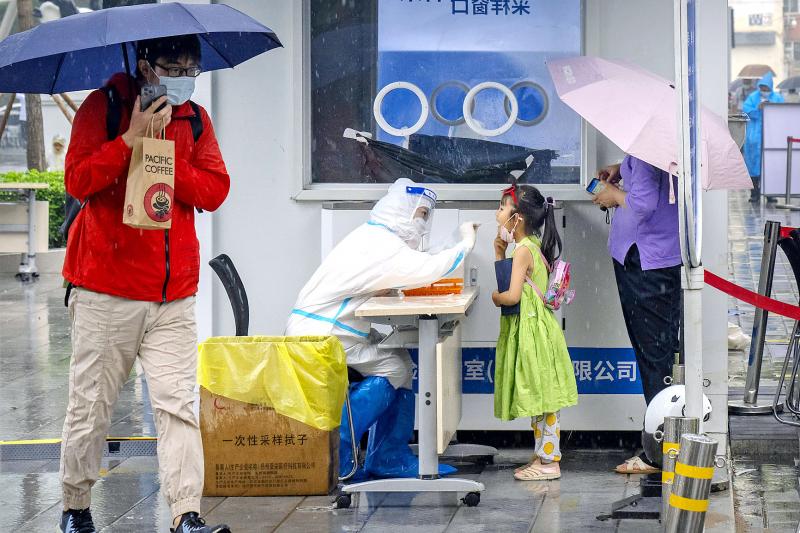Beijing is tightening its hardline “zero COVID” rules, mandating that children show a negative test result to enter parks in China’s capital.
Children older than three will need to show a green health code on the system that controls people’s movements, as well as a negative COVID-19 result no older than 72 hours, a statement from the Beijing Municipal Administration Center of Parks said.
Previously, children were able to go to parks and other public places without getting their test results checked provided their parents met requirements for entry.

Photo: AP
China is relying on frequent testing to identify, then quash, transmission chains early even as its zero-tolerance approach comes under increasing strain from more transmissible variants and isolates it from the rest of the world.
While Beijing has contained its recent flare-up without a widespread lockdown, authorities in the city are under immense pressure to control the situation ahead of the party congress in the second half of the year, when Chinese President Xi Jinping (習近平) is expected to secure an unprecedented third term as leader.
Getting a test is not particularly onerous and children have had to participate in previous rounds of mass testing. China is setting up tens of thousands of booths across the country, initially with a focus on major cities, to meet a pledge to ensure residents will always be just a 15-minute walk away from a swabbing point.
Still, the new rule was seen as extreme even by a population that has been subject to varying degrees of pandemic curbs. A hashtag linked to the story was one of the top five trending items on China’s Sina Weibo yesterday morning, with posters questioning how useful the policy will be.
For children wanting to play in parks, they will now need to swipe their national identification cards on a machine or have their health status checked via someone else’s phone.
Beijing’s most recent cluster was linked to a bar, and there has never been an infection linked to a park. More than 95 percent of Chinese children between three and 17 years old are now fully vaccinated, according to latest data.

The Burmese junta has said that detained former leader Aung San Suu Kyi is “in good health,” a day after her son said he has received little information about the 80-year-old’s condition and fears she could die without him knowing. In an interview in Tokyo earlier this week, Kim Aris said he had not heard from his mother in years and believes she is being held incommunicado in the capital, Naypyidaw. Aung San Suu Kyi, a Nobel Peace Prize laureate, was detained after a 2021 military coup that ousted her elected civilian government and sparked a civil war. She is serving a

REVENGE: Trump said he had the support of the Syrian government for the strikes, which took place in response to an Islamic State attack on US soldiers last week The US launched large-scale airstrikes on more than 70 targets across Syria, the Pentagon said on Friday, fulfilling US President Donald Trump’s vow to strike back after the killing of two US soldiers. “This is not the beginning of a war — it is a declaration of vengeance,” US Secretary of Defense Pete Hegseth wrote on social media. “Today, we hunted and we killed our enemies. Lots of them. And we will continue.” The US Central Command said that fighter jets, attack helicopters and artillery targeted ISIS infrastructure and weapon sites. “All terrorists who are evil enough to attack Americans are hereby warned

Seven wild Asiatic elephants were killed and a calf was injured when a high-speed passenger train collided with a herd crossing the tracks in India’s northeastern state of Assam early yesterday, local authorities said. The train driver spotted the herd of about 100 elephants and used the emergency brakes, but the train still hit some of the animals, Indian Railways spokesman Kapinjal Kishore Sharma told reporters. Five train coaches and the engine derailed following the impact, but there were no human casualties, Sharma said. Veterinarians carried out autopsies on the dead elephants, which were to be buried later in the day. The accident site

‘EAST SHIELD’: State-run Belma said it would produce up to 6 million mines to lay along Poland’s 800km eastern border, and sell excess to nations bordering Russia and Belarus Poland has decided to start producing anti-personnel mines for the first time since the Cold War, and plans to deploy them along its eastern border and might export them to Ukraine, the deputy defense minister said. Joining a broader regional shift that has seen almost all European countries bordering Russia, with the exception of Norway, announce plans to quit the global treaty banning such weapons, Poland wants to use anti-personnel mines to beef up its borders with Belarus and Russia. “We are interested in large quantities as soon as possible,” Deputy Minister of National Defense Pawel Zalewski said. The mines would be part